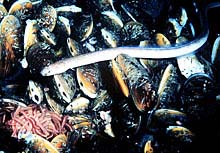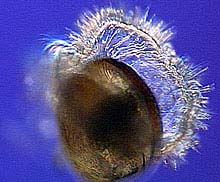
Deep-sea mussels living on the “shore” of the Brine Pool. These mussels use methane as their primary source of food, but also filter small particles from the water. The red worms in the bottom left corner are a newly described species of polychaete. The large fish in the middle of the picture is a deep-sea eel. Such fishes commonly visit the Brine Pool, where there is more abundant food than elsewhere on the deep-sea floor. Click image for a larger view.
Seasonal Breeding in Mussels
Craig M. Young
Oregon Institute of Marine Biology
Like many flowering plants, marine animals in shallow water generally reproduce during specific seasons of the year. Changing day length, rising temperature, moon phases and other seasonally changing signals tell these animals when they should breed. In the deep sea, where sunlight does not penetrate and temperatures remain constant and cold, most animals breed continuously, presumably because they experience no seasonal changes. There are, however, some animals that breed seasonally even under the constant conditions of the deep sea. One of the major mysteries of deep-sea oceanography is how these animals know when seasons are changing far above them. One popular idea, which remains unproven, suggests that the microscopic algae that fall to the sea floor from dying plankton blooms provide both a signal for reproduction and the energy required to make gonads
Mussels living near methane seeps in the Gulf of Mexico are among the unusual deep-sea animals that breed seasonally. These animals mature from the early spring through the late fall, then spawn (release eggs and sperm) in the middle of the winter. There are several indications of seasonal breeding in cold seep mussels. First, the gonads of mussels are small during the summer and increase in size in the fall and winter months. Second, baby mussels may be found in the water, as much as several hundred meters above the bottom, during the winter months, but not during the spring or summer. Finally, tiny mussels are found at the brine pool only during the early part of the year.

A larval mussel captured during the winter several hundred meters above the brine pool. The hinged shell is visible below. The delicate tissue above the larva is the velum, which has cilia (moving hairlike structures) that the larva uses for movement and feeding. Click image for larger view.
Seasonal breeding in mussels is especially puzzling because these mussels can obtain all of the energy they need for survival and growth from methane bubbles on the ocean floor. Bacteria living in the mussel gills convert methane into carbon for building tissues and for providing energy to support growth and metabolism. On this expedition, we are trying to determine how deep-sea animals know when to reproduce by studying egg production and the chemistry of gonads in cold-seep mussels. Although the mussels get most of their energy from methane, they also are capable of filtering tiny particles, including bacteria, from seawater. Therefore, it is possible that they use microscopic plants and detritus (dead organic matter) that fall to the sea floor to fuel the reproductive cycle even if they do not need such material for metabolism and growth.
Organic matter originating from photosynthetic plants has a different chemical signal than organic matter originating from chemosynthetic bacteria at methane seeps. We can use these differences to determine where the carbon in different animal tissues originated. By examining the lipids (fats) in mussel gonads and non-gonadal tissues, we will try to determine if food falling from above might cue the reproductive cycles in deep-sea animals. Our main study site is the Brine Pool, which has the largest population of mussels in the Gulf of Mexico.
Sign up for the Ocean Explorer E-mail Update List.























